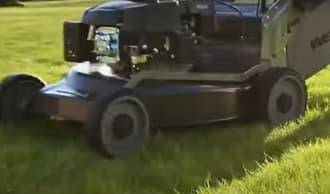As an Amazon Associate, this site earns commissions from qualifying purchases. For more information click here.
Does your lawn mower start and run fine when it’s cold, but performance dips when it gets hot? Or worse, the engine stalls? It can be frustrating since we use lawn mowers when the sun is out. As someone who has had to deal with this personally, I did a lot of research to figure out the causes and how to fix them.
The most common reason is a faulty spark plug. But it could also be due to an overheating engine, clogged carburetor or damaged coil.
Faulty Spark Plug
I will start with the most likely cause: a defective spark plug. If your lawn mower has trouble starting or stalls when it is hot, this is the first place to look.
There are many reasons why a spark plug goes bad: soot buildup, worn out, warping, burned out, cracked parts, etc.
Turn off the lawn mower and check the spark plug. If it looks burnt or covered with soot/dirt, replace it. It is possible to clean a spark plug, but you should be replacing it at least once a year. You can use a Flada Spark Plug Tester to determine if it is still working.
Spark plugs are cheap and widely available. Just make sure it is compatible with the lawn mower. Check the manual for the specific type of spark plug it needs. You must get an exact match.
Engine Problems
An overheated engine is one of the most common reasons why lawn mowers stall when it is hot. Intense heat has a negative effect on the engine and eventually it will stall or completely stop.
Lawn mowers have cooling fins which dissipate heat, allowing the engine to run continuously. As you mow, grass clippings, dust and dirt build up around the cooling fins and clog it.
The fins, which are supposed to cool the engine, does the opposite. The grass and dirt block the fins and trap heat inside, causing the temperature to rise. This forces the engine to shut down.
The solution is to clean the fins. Turn the lawn mower off, let the engine cool and remove the casing. Use a brush or clean rag to remove grass, dirt, twigs etc. Put the casing back on.
Turn the lawn mower back on and it will run normally. Clean the cooling fins regularly to avoid dirt buildup.
Broken Ignition Coil
Also known as the flywheel magneto, it produces voltage that spark plugs use. If the engine is overheating, the coil will have a hard time generating voltage.
An overheated engine is just one possible cause. Old, worn out coils sometimes just stop working. You can use a multimeter or an ignition coil tester like the Ram Pro to check if it is working.
If you have to replace the coil, check the manual for the exact type you will need. Like spark plugs, lawn mowers need a specific coil to work.
Defective Carburetor
Problems with the carburetor directly affect the engine. The most likely reason is the carburetor has been clogged by old gas deposits.
If gas has been left in the tank for more than a month, it turns gummy. This substance clogs the carburetor and prevents it from working properly.
Cleaning is the best solution. Get a carburetor cleaning kit and spray. I recommend LImeiy Carburetors for the cleaning and the STA-BIL Fast Fix for this. When you are done, try the lawn mower again.
If that does not solve the problem, the carburetor might have physical damage. You have two options: fix the carburetor or buy a new one. I would rather buy a new one. They are affordable and fixing carburetors can be time consuming.
Malfunctioning Valves
Compression problems are caused by faulty valves. You can test this by pulling the starter cord. If it pulls to easily, the valves are not working properly. Most likely the valve clearance is too large.
There are many reasons why this can happen, but often it is due to an overheating engine. It could also be due to the valve itself being broken.
Fixing or replacing valves is not for everyone. You should only do this if you have experience with tools and DIY. This video shows you how..
Fuel Issues
Lawn mowers need the right gas to run. Regular unleaded 87 octane E10 is the best. Premium gas works but don’t expect major improvement. Even with the right gas, a number of issues can come up.
Old gas. Replace the gas every 30 days. If you are going to store the mower, drain the tank or put fuel stabilizer in it. If you don’t, old gas will turn into sludge and clog the engine.
Too little or too much fuel. If you put too little gas, the engine will not run. If you put too much gas, it might flood. Put only the exact amount required amount by your lawn mower. Fill the tank only up to the designated line.
Wrong fuel. Most lawn mowers are 4-stroke and have separate oil and gas tanks. 2-stroke lawn mowers mix oil and gas. Do not mix oil and gas in a 4-stroke lawn mower because it can damage the engine.
Loose Bolts and Screws
The bolts and screws on a lawn mower can come loose for various reasons. A part was replaced and the screw wasn’t tightened securely, or perhaps a bump caused one or more bolts to come loose.
Loose bolts will cause all kinds of problems. If the bolt is close to the fuel tank, gas could leak out or air seep in. Either way it will have a negative impact on the engine. Eventually the engine is going to shut down.
If you have an old lawn mower, check the screws and bolts regularly. They might suddenly come off while you’re using it. This can cause the engine to stop or something worse. If the bolts holding the blade loosens, the blade will detach from the mower.
Perform a thorough nuts and bolts check during maintenance. Tighten any loose ones you see. Replace any bolts if required. Pay close attention to the bolts on the engine and the blades. Never run a lawn mower if one of the bolts is missing. Get a replacement that is an exact match.
Worn Out Air Filter
Lawn mower air filters shield the carburetor from debris. Because of this, the filter accumulates dirt, debris, grass clippings and dust. If the filer gets clogged, the trapped dirt can spread throughout the engine.
You can clean air filters, but often it is better to replace it. The rule of thumb is to replace these filters after every 25 hours of use. If your lawn mower has a foam filter, it can be cleaned and reused. Paper filters are on-time use only though.
If you want to clean the filter, it is easy to do so. Lift the filter housing cover off. Take out the filter and brush the dirt off. Wash under running water if needed. Squeeze excess water out but be careful not to tear the filter. As you clean the filter, check for any signs of tears. If the filter is already damaged, get a new one.

A Dirty Mower Deck
The deck keeps grass clippings and dirt from flying everywhere, but it does accumulate. If there is too much clogging, the blade will not be able to turn. This forces the engine to work harder to make the blade spin, causing it to overheat.
To test this, pull the starter rope. If it takes more effort than usual to pull (or is stuck), the deck might be stuffed with clippings and debris.
Turn off your lawn mower. After the engine cools, flip it over and inspect the deck. Odds are there will be a lot of debris, grass, twigs and other materials scattered. Use a trowel or similar tool to scrape them off.

I love the outdoors and all the tools for maintaining gardens, yards and lawns. The only thing I am more passionate about is sharing what I know about garden and outdoor equipment.


